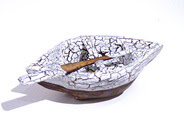On Sunday afternoon, Bob and I headed out of Newcastle for a long journey to Oxford. Under normal circumstances the trip would have been under 5 hours, but disruptions from heavy rain south of the country experienced last week, threw the regional railway system in chaos and our journey extended to well over 6 hours.
We reached Oxford around 10pm and checked into a lovely hotel, the Oxford Royal Hotel before walking about half a mile to find the closest restaurant with an open kitchen.

We stumbled upon an Italian restaurant, Branca, in a neighbouring suburb called Jericho for fresh Italian bread and hot plates of pasta.

By the time we reached our hotel rooms it was quite late night and we were up early the following morning to fit in breakfast before our day at Said Business School.

Since December 2006, a group of service design practitioners, science and technology entrepreneurs and academics have been participating and observing in a program called Designing for Services in Science and Technology-based Enterprises. The aim was to explore how ideas for designing services change when service designers and science and technology entrepreneurs work together.
The service design firms and science and technology entrepreneurs were paired up and worked together over a period of eight months. These pairs included service designers from IDEO, live|work and radarstation. The science and technology entrepreneurs included Oxford Gene Technology (OGT), Prosonix and G-Nostics.
On Monday, each pair gave a final presentation on what happened, their process, the outcomes and their learnings. The details and discussions after were fascinating, bringing up challenging questions for designers in the business world, such as how do designers differentiate themselves from operations and marketing in management consultancy?

Each science and technology entrepreneur found the process of great value (all three entrepreneurs spoke of continuing a relationship with the service design firms). The designers exposed them to different ways of thinking and doing. Some of the more unique activities that designers brought to the table included, having a dialogue with customers to gain insights and future concept articulations (what IDEO called “Adcepts”).

A few workshops rounded up the day, including a workshop around developing a service design vocabulary. Some of us headed to the pub, The Honey Pot, for a drink before a dinner Oxford University put on for the group, with speakers from IBM’s Almaden Services Research Centre, branding agency Wolff Olins (who recently launched the London 2012 Olypimics logo) and London Business School.
It was a full-on day of soaking up the content and meeting designers, entrepreneurs and academics in the fields of design and business.
